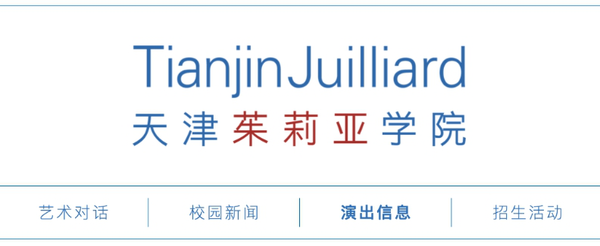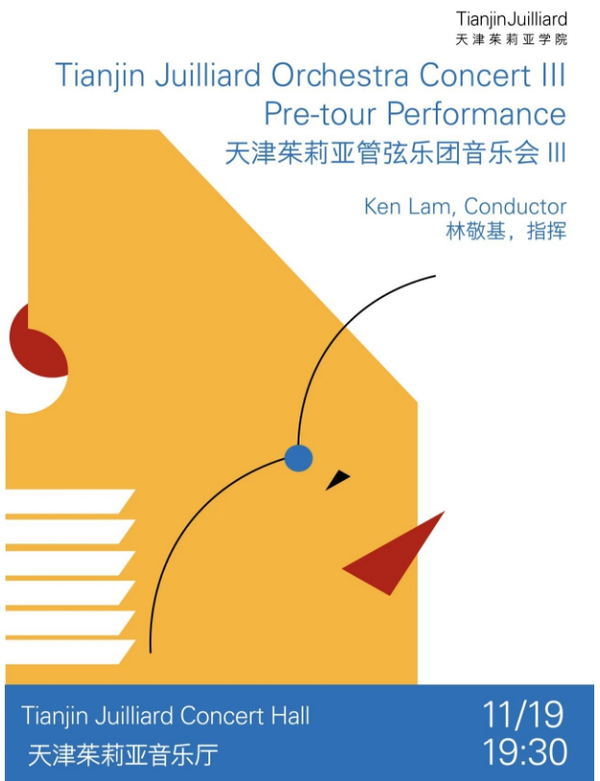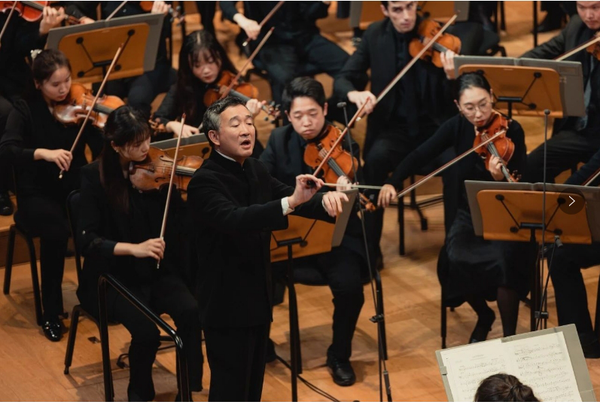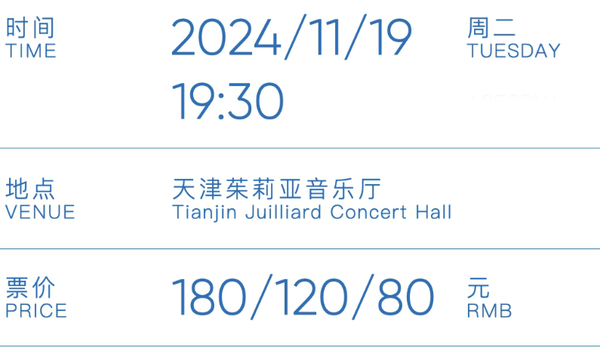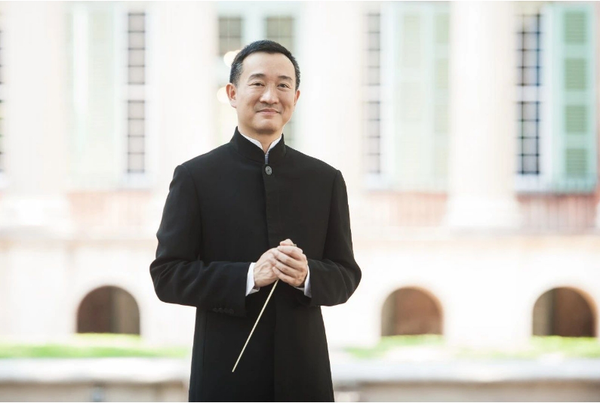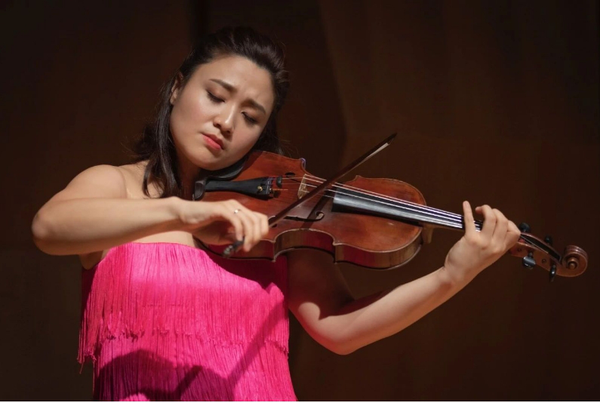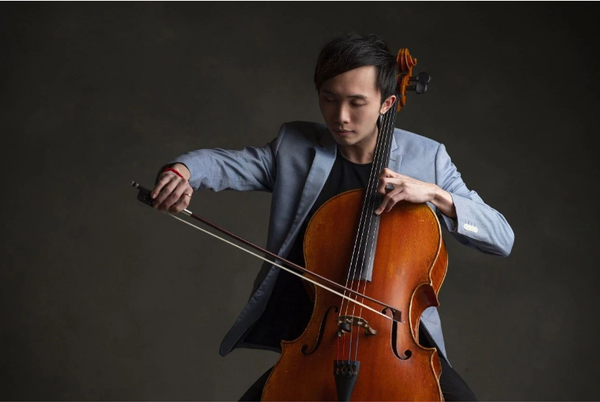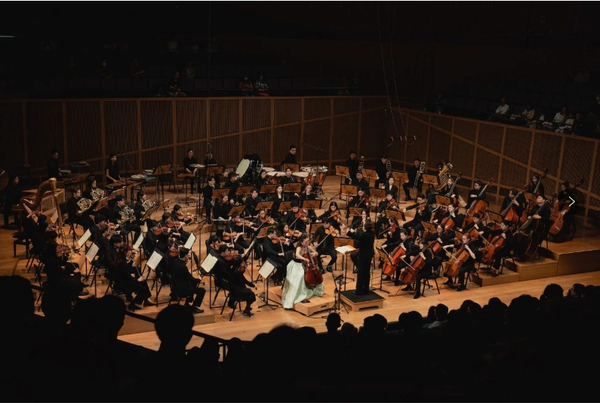节目单|天津茱莉亚管弦乐团巡演音乐会
稿源:天津茱莉亚学院 编辑:李若怡 2024-11-18 10:49
本周,天津茱莉亚管弦乐团将开启首次巡演,驻团指挥林敬基(Ken Lam)执棒,两位学院常驻教师担纲独奏:中提琴家李汉娜(Hanna Lee)演奏马克斯·布鲁赫的《F大调浪漫曲》,大提琴家何思昊演奏柴可夫斯基的《洛可可主题变奏曲》。同时,乐团还将演绎华裔作曲家周天的《礼献》、保罗·杜卡的《魔法师的学徒》、哈恰图良《斯巴达克斯》的慢板,以及里姆斯基-科萨科夫的《西班牙随想曲》,呈现一套极富音乐性和深度的曲目。
11月19日,天津茱莉亚管弦乐团将在天津茱莉亚音乐厅举行2024-25乐季第三场音乐会。随后,他们将于11月20日登台北京国家大剧院,参加“春华秋实”艺术院校舞台艺术精品展演;并将于11月24日奏响香港大会堂,献艺香港新世代艺术协会音乐节。期待与各地观众在音乐厅里相见!
19日演出前,天津茱莉亚将举办音乐会导赏。当日18:30于天津茱莉亚演奏厅内,驻团指挥林敬基与演出项目制作经理职承将带领大家深入了解本场演出的曲目策划与作品解读,音乐会购票观众可凭票入场。
购票方式
天津|天津茱莉亚音乐厅
11月19日,19:30
北京|国家大剧院
11月20日,19:30
香港|香港大会堂
11月24日,19:30
天津茱莉亚管弦乐团
音乐会 Ⅲ
TIANJIN JUILLIARD ORCHESTRA
CONCERT Ⅲ
林敬基,指挥
李汉娜,中提琴
何思昊,大提琴
Ken Lam, Conductor
Hanna Lee, Viola
Sihao He, Cello
演出曲目
PROGRAM
周天(b. 1981)
《礼献》
ZHOU TIAN (b. 1981)
Gift
马克斯·布鲁赫(1838-1920)
浪漫曲——为中提琴与乐队而作
李汉娜,中提琴
MAX BRUCH (1838-1920)
Romance for Viola and Orchestra
Hanna Lee, Viola
彼得·伊里奇·柴可夫斯基(1840-1893)
洛可可主题变奏曲
何思昊,大提琴
PYOTR ILYICH TCHAIKOVSKY (1840-1893)
Variations on a Rococo Theme
Sihao He, Cello
中场休息
INTERMISSON
保罗·杜卡(1865-1935)
《魔法师的学徒》
PAUL DUKAS (1865-1935)
The Sorcerer’s Apprentice
阿拉姆·哈恰图良(1903-1978)
慢板,选自《斯巴达克斯》第二组曲
ARAM KHACHATURIAN (1903-1978)
Adagio from Spartacus Suite No. 2
尼古拉·里姆斯基-科萨科夫(1844-1908)
《西班牙随想曲》
NIKOLAI RIMSKY-KORSAKOV (1844-1908)
Capriccio espagnol
本场演出曲目以现场演奏为准
The program is subject to change
周天
《礼献》
ZHOU TIAN
Gift
寻觅东方神韵的本源,华裔作曲家周天的《礼献》一开篇便揭示了一幕宏大的景象,其灵感源于南北朝诗人沈约的乐府诗《梁雅乐歌·献雅》。诗歌采用四言六句的格式,乐曲的主题则是一声仰天长啸,念出那诗中的“神宫肃肃”,音律的高低起伏为后续的起承转合打下基础。主题不断的循环往复,高音区与低音区频繁对答。此后,鼓乐升腾,在短促而重复的节奏中,献祭的供品被声浪缓缓托起,主题归来,悠远壮丽,好似一幅无边无际的美丽长卷,谱写着中华大地永恒的伟大诗篇。作品由上海交响乐团和音乐总监余隆在乐团建立140周年之际委约。
I consider Gift something of a homecoming. As I began a residency with the Shanghai Symphony, I wanted to create a reminder of the joy of music making, and along the way explore my own musical identity after 18 years of living abroad. The title, “Gift” (礼献), came from a poem titled “Music as a Gift of Decency” by Shen Yue from the Northern and Southern dynasties (ca. 400).
The piece is shaped around a folky 4-note motif, which rises and falls against a large orchestral palette throughout its 9-minute duration. In a nutshell, this is my gift to fellow musicians.
Gift was commissioned by the Shanghai Symphony and Music Director Long Yu for the opening of the orchestra’s 140th concert season. The New York Philharmonic conducted by Long Yu gave the US premiere of the work on 28 January 2020 at David Geffen Hall at Lincoln Center, New York.
中文版由职承撰写
Chinese Version By Cheng Zhi
英文版由周天撰写
English Version By Zhou Tian
马克斯·布鲁赫
浪漫曲——为中提琴与管弦乐队而作
MAX BRUCH
Romance for Viola and Orchestra
对于很多专业的音乐学习者而言,马克斯·布鲁赫或许显得陌生。然而,当他们听到那首令人难以忘怀的第一小提琴协奏曲时,会再次翻开厚重的历史课本,寻找这位被淡忘的作曲家的名字。
马克斯·布鲁赫,19世纪末德国浪漫派晚期作曲家,曾著有200多首作品,代表作有G小调第一小提琴协奏曲,《苏格兰幻想曲》,为大提琴与管弦乐团而作的《晚祷》,以及多首合唱作品等。《F大调浪漫曲》是布鲁赫献给其挚爱乐器——中提琴的一封简短但真切的情书。弦乐的上行揭开序幕,中提琴的进入宛若破晓之光,照亮了世间一切冰冷与黑暗。惆怅的小调带来了远方恋人的思绪,而短促的停顿无法阻止音乐向前延伸的渴望,乐队再次奏出主题。乐曲中间,木管的加持使得中提琴展现出深邃与张力,此后,双簧管穿针引线,浪漫的主题重现。中提琴在不同调性上探索游走,最后在宁静中依依不舍的消逝而去。
Max Bruch was a German composer. He began learning music at an early age from his mother, who was a singer, started composing at the age of nine, and completed a septet for woodwinds and strings when he was only eleven. At the age of fourteen, he won the coveted Frankfurt Mozart-Stiftung Prize.
Bruch composed a number of choral works, both sacred and secular as well as an opera based on Goethe's Scherz, List und Rache at the age of twenty. His love for the human voice went hand in hand with a remarkable melodic gift, a talent that is also evident in his compositions for solo strings. Although his Violin Concerto No. 1 in G Minor is by far the most well-known, Bruch’s friendships with prominent violinists of the time — such as Joachim, Sarasate, and Willy Hess — inspired him to compose extensively for this instrument (he wrote ten concerted works for violin). Bruch was deeply influenced by Mendelssohn and Brahms, which shaped his compositional style throughout his career. This Romance in F Major for viola and orchestra, with its clear, flowing melodies expressed through the warm, rich sound of the viola, is a perfect encapsulation of German musical Romanticism.
The Romance follows a very traditional sonata form. The exposition presents two fully developed theme groups that form two distinct, contrasting sections. After the first theme group in F major, the second theme group appears suddenly and resolutely in A-flat Major. This section features wide leaps and faster moving notes, providing a clear contrast to the first theme group. During the final section of the exposition the melody alternates between the solo viola and the orchestra, finally ending in the traditional dominant key — C Major, completing a Brahmsian three-part tonal design.
The development focuses on the musical ideas from the first theme group, accompanied by the solo viola's restrained technical display. The music gradually approaches a climax with upward sweeping arpeggios, followed by two appearances of a Neapolitan sixth chord of G Minor. Finally, an augmented sixth chord moves the music smoothly to E-flat Major, where this section ends quietly.
A short passage derived from the first theme and a deft series of chords serve to prepare the recapitulation in the home key of F major. This takes the form of a shortened version of the exposition in which the first theme is accompanied by string pizzicati and the orchestration is brighter. The piece ends with a final recall of the opening theme that fades away to silence.
中文版由职承撰写
Chinese Version By Cheng Zhi
英文版由许樱宝撰写
许樱宝,MM’26,合作钢琴
English Version By Yingbao Xu
MM '26, Collaborative Piano
彼得·伊里奇·柴可夫斯基
洛可可主题变奏曲
PYOTR ILYICH TCHAIKOVSKY
Variations on a Rococo Theme
1876年底,在德国大提琴家威廉·菲茨哈根的帮助下,柴可夫斯基对大提琴有了更深的了解,并在前者的协助下创作了洛可可主题变奏曲,菲茨哈根也是此曲的被献者。柴可夫斯基深受莫扎特音乐风格的影响,试图将洛可可这一精致华美的风格镶嵌在大提琴那入木三分的音与音之间。
全曲的主题被标记为纯朴的中板,在圆号从容的引子后,大提琴朴实无华的主题奏出,弦乐轻柔的点缀迎来了木管勾勒的独特颜色,大提琴也在不经意间悄然步入第一变奏。循序渐进,轻重缓急,大提琴在不同的变奏中开启了一扇扇不同色彩与纹理的音响之门。C大调的第三变奏堪称柴可夫斯基最优美的旋律之一,而尾声则在D小调的片刻惆怅后横空出世,变奏中精彩的片段在此交融,大提琴在高低音区之间自由的穿梭,并在乐队的承托下将全曲推向辉煌的终点。
Tchaikovsky’s Variations on A Rococo Theme is scored for solo cello and a reduced orchestra consisting of pairs of woodwinds, two horns and strings.
The Rococo style in question was a special ornamental style of architecture and art that began in France in the 1730s as a reaction against the more formal royal style. It combines asymmetry, soft curves, gilding, and pastel colors, emphasizing elegance over seriousness. Fashions of the time included large dresses in white and pastel colors painted with little flowers, and decorated by bowknots, flounces and laces. Some women also wore extravagant round hats. The analogous contemporary musical style was also light and elegant, delicate yet relaxed. An idealized version of the lost elegance of the 18th century was important for Tchaikovsky, whose favorite composer was, after all, Mozart.
Tchaikovsky’s work is based on an original “Rococo” melody that is developed over a series of variations organized around changing rhythmic patterns and contrasting tempos and moods. For instance, the first variation uses triplets to decorate main melodic line, while the second variation consists of rapid scales, which passed back and forth between the soloist and the orchestra. In the slow third and seventh variations the theme recedes further into the background, helping to set the stage for subsequent changes of mood. The cello cadenza in the fifth variation and the celebratory final variation both make extraordinary technical demands on the soloist.
The first version of the work contained eight variations. However, after the premiere played by the composer’s friend Wilhelm Fitzenhagan, a German cellist and professor at the Moscow Conservatory, the soloist rearranged the variations and reduced their number to seven, making the piece easier to play but just as effective. This commonly performed version will be heard here. The duration of the entire piece is around 18 minutes, and the variations are performed without break. Although quite short compared to other cello concertos, it is rich in both virtuosity and emotional expression, making it a standard of the cello repertoire.
中文版由职承撰写
Chinese Version By Cheng Zhi
英文版由刘芸贝撰写
刘芸贝,MM’26,大提琴,管弦乐表演
English Version by Yunbei Liu
MM '26, cello, Instrumental and Chamber Music Studies
保罗·杜卡
《魔法师的学徒》
PAUL DUKAS
The Sorcerer’s Apprentice
那个老巫师已经消失了|这一次已经消失了!|被他召唤的灵魂,现在被放逐,|我的命令很快就会服从。|每一步和每一句话|我知道他用过,|精灵们服从|我将展示我的艺术。
这是德国伟大诗人歌德的诗“魔法师的学徒”的首段。或许,恰恰是受到这学徒神秘艺术的指使全世界才拜倒在法国作曲家保罗·杜卡音乐的魔法棒之下。歌德的诗早于杜卡的作品一百年,在诗中,一位学徒偷听到了魔法师的咒语,于是在其离家之后,自行向一把扫帚施法。扫帚活了过来,开始帮助学徒挑水,可他只偷听到咒语的一半,只知开头不知解咒。顿时,停不下挑水的扫帚让家中洪水泛滥,学徒惊慌失措,直到魔法师返回,用一句“我烦人的精灵,忽视我的命令”平息了一切。
杜卡的手法是描述性的,交响诗《魔法师的学徒》与德彪西、施特劳斯的同类作品有着异曲同工之妙。作品开头速度的突然变化描绘了蹑手蹑脚的学徒,加上弱音器的小号奏出了碎片式的咒语。木管一顿一顿的好似刚挺起身子的扫帚,飘逸的弦乐犹如水与魔咒的交融。无形变有形,起初的水花演变成波涛汹涌声浪,在音量的最高点,铜管齐奏,魔法师回来了,一切又都回到了从前。
French composer Paul Abraham Dukas was intensely self-critical, burning most of the compositions that didn’t meet his exacting standards before his death. Dukas’s musical style bridged late romanticism and early 20th century Modernism, known in its French incarnation as impressionism. He was a formidable pedagogue, teaching many celebrated composers including Olivier Messiaen. While his earlier works are in a kind of academic 19th century style, he later fell under the influence of Debussy and Ravel, contributing to the same rich musical milieu. The Sorcerer’s Apprentice falls somewhere near the middle of this stylistic evolution. Among Dukas’s few surviving works, it is by far the most well-known: more well-known even than the composer himself. In particular, it is familiar from its appearance in Disney’s 1940 film, Fantasia. Dukas composed the piece in 1897, basing it on Johann Wolfgang von Goethe’s celebrated poem Der Zauberlehrling. This narrative poem relates the story of an old sorcerer who leaves his apprentice to perform household duties and fill the bathtub with water. The young apprentice uses magic spells in which he is not well-trained to command a broom to life to help him carry buckets of water from the river to fill in the bathtub, but he does not know how to command the broom to stop, and the water begins to overflow and flood the house. He uses an axe to chop the broom in half, but it merely becomes two brooms working relentlessly at twice the speed. After all chaos, the old sorcerer finally returns home in time to restore order. The music hews to all of this with vivid faithfulness, making it obvious choice to adapt into a cartoon.
The piece begins with an introduction that introduces all the important thematic elements contained in the work. An atmospheric theme in the strings is followed by a second theme announced in the clarinet. This is the work’s principal theme representing the enchanted broom, and the listener is first given the chance to become familiar with it in this slower tempo. A brief switch to a faster tempo introduces the apprentice’s lively theme in the woodwinds. This is followed in turn by an imperious call in the trumpets whose appearance signals the arrival of the sorcerer on the musical stage. The onset of the main allegro starts the musical narrative on its way. The iconic magic broom theme is given to the bassoon, and the apprentice’s theme is presented by woodwinds and glockenspiel. The two themes confront each other over the course of an intense and increasingly chaotic development until the sorcerer’s theme is played by the brass to represent the apprentice’s attempt to stop the broom by chopping it. His efforts fail, and the music slowly regains tempo. The magic broom’s theme is restated by both bassoon and clarinet, representing the two brooms that were the result. An even more intense development of the broom theme and the apprentice’s theme is halted by another eruption of the sorcerer’s theme in the brass as he finally returns to put a stop to all the chaos. A short coda restates the atmospheric string theme from the introduction as well as a chastened fragment of the apprentice’s theme in a solo viola, after which a sudden four-note interruption brings the work to an abrupt conclusion.
中文版由职承撰写
Chinese Version By Cheng Zhi
英文版由Thananan Rochanakit撰写
MM’26,打击乐,管弦乐表演
English Version By Thananan Rochanakit
MM '26, percussion, Instrumental and Orchestral Studies
阿拉姆·哈恰图良
慢板,选自《斯巴达克斯》第二组曲
ARAM KHACHATURIAN
Adagio from Spartacus Suite No. 2
古老的英雄传说,对自由炙热的渴望。《斯巴达克斯》是亚美尼亚作曲家哈恰图良创作的一部三幕芭蕾舞剧,叙述了色雷斯国王斯巴达克斯在罗马执政官克拉苏的压迫下,率领战俘们奋起抵抗并最终牺牲的史诗,作品于1954年荣获列宁奖章。
与很多同时代的作曲家一样,哈恰图良将舞剧中经典的桥段改写为管弦乐组曲。其中,慢板描绘了在成功挣脱罗马人的枷锁后,斯巴达克斯与弗里吉亚这两位恋人相待的温馨场景,为第二组曲揭开序幕。乐曲开端,弦音的轻柔宛如微弱的焰火,颤动的笛声与上行的大提琴引领着勇士寻觅恋人的踪迹,双簧管倾吐出远方异乡的咒语,不久,深邃醇厚的弦乐升腾而起,拨开重重迷雾,恋人终于重逢……
Spartacus is a three-act ballet by the Soviet Armenian composer Aram Khachaturian, telling the epic tale of the Thracian king Spartacus: an ancient hero’s legend of fervent yearning for freedom. Under the oppression of the Roman consul Crassus, Spartacus led his fellow captives in a courageous uprising, eventually sacrificing himself. The work was awarded the Lenin Prize in 1954.
Like many composers of his time, Khachaturian reworked iconic scenes from his ballets into orchestral suites. The Adagio of Spartacus and Phrygia from the second suite evokes a tender moment between the two lovers after they escape Roman captivity. The piece begins softly, with delicate string passages that flicker like gentle flames, while tremulous flute and ascending cello lines guide the warrior in search of his beloved. An oboe then weaves in distant, foreign incantations, and soon the profound, rich strings rise, parting the fog as the lovers are finally reunited.
曲目介绍由职承撰写
Program Notes By Cheng Zhi
尼古拉·里姆斯基-科萨科夫
《西班牙随想曲》
NIKOLAI RIMSKY-KORSAKOV
Capriccio espagnol
在诸多层面上,尼古拉·里姆斯基-科萨科夫都是俄罗斯音乐的中心人物。他是交响乐配器的大师,交响乐团在他的笔下变成了一个绚丽多彩的画板,其影响不仅局限于俄罗斯音乐中,更是遍及至全世界——保罗·杜卡、雷斯庇基、拉威尔、德彪西皆尊崇里姆斯基-科萨科夫为导师;而改变了20 世纪音乐格局的鬼才伊戈尔·斯特拉文斯基也曾是他在圣彼得堡音乐学院的弟子;交响组曲《天方夜谭》中所呈现的配器手法,更是对后世电影配乐的理念产生了深远影响。
孤傲潇洒的吉普赛舞者在喧嚷的人群中一跃而起,鲜艳夺目的裙摆使在场的人们都为之陶醉。在里姆斯基-科萨科夫的脑海里,这位舞者便是充满魔力的小提琴。《西班牙随想曲》起初的蓝图实则是一首小提琴与乐队的作品,可在大师的鬼斧神工下它变成了小提琴、单簧管、双簧管、长笛、圆号、小号尽情挥洒各自魅力的舞台。五个乐章一气呵成:乐队的欢腾支撑起单簧管与小提琴两位竞技的舞者,圆号随后奏出了西班牙古老的歌谣。狂欢依旧,直到小号明亮的宣告“吉普赛艺术家们”的到来,乐队中每件乐器各尽所能,演奏相似的旋律但塑造截然不同的形象,它们在广阔的音海中尽情的表现着触动人心的生命力!
After the success of Rimsky-Korsakov's two orchestral compositions with Russian folk song elements, Fantasia on Two Russian Themes and Little Russian Fantasia, he conceived the idea of writing a piece incorporating Spanish folk music— the Capriccio espagnol. This capriccio was initially intended to be a virtuoso violin fantasy on a Spanish theme, but it was completed in 1887 as a virtuoso orchestral composition instead. It was a tremendous success at its premiere in the autumn of 1887, directed by Rimsky-Korsakov himself. Along with Scheherazade and the Russian Easter Festival Overture, it one of Rimsky-Korsakov's most well-known orchestral compositions (otherwise, the composer’s output is dominated by opera). Its virtuosity and unique coloration set it apart among this trio of ubiquitous works, and various solo passages display a wide variety of instrumental timbres. Unlike Tchaikovsky, who actually wrote his Capriccio Italien in Italy, this piece, so rich in Spanish color, was composed entirely in Russia. Although Rimsky-Korsakov never actually experienced Spanish culture first hand, he acquired these musical elements in two ways. Foremost was the influence of Mikhail Glinka, a composer of the preceding generation who is often regarded as the founding figure of Russian classical music. Glinka traveled to Spain where he gathered materials and wrote several pieces inspired by Spanish folk music. Second, Rimsky-Korsakov possessed a collection of Spanish songs which may have been acquired during his three years of military service in the Russian Navy.
The composer said, “To me even a folk theme has a programme of sorts,” and many of his orchestral compositions are highly programmatic. The Capriccio espagnol is cast in five consecutive sections, each of which has a title that sums up the tone and musical style of that particular section. The first movement, “Alborada,” opens with a festive dance-like passage followed by solos for clarinet and violin. The materials come from Asturian folk music used to celebrate the sunrise. The second movement “Variazioni” features another Asturian song. Interestingly, the folk song was written down with the instruction to “sing with a harsh and loud voice,” a far cry from Rimsky’s lyrical setting for horn quartet. The third movement “Alborada” marks a return to the music of the first movement, this time in B-flat Major instead of A Major. In addition, the clarinet and violin solo passages reverse roles. Throughout the fourth movement, “Scena e canto gitano” (Scene and Gypsy Song), the composer employs an Andalusian gypsy song. It is comprised of five cadenzas performed by the horn and trumpet, violin, flute, clarinet, and harp. These serve to highlight both the individual timbres of each solo instrument as well as their virtuoso characteristics. An ascending chromatic scale in the violins and woodwinds leads to the final movement, “Fandango asturiano”. This Fandango is a vigorous triple-time dance, after which the piece concludes with one last reappearance of the opening theme in the coda.
中文版由职承撰写
Chinese Version By Cheng Zhi
英文版由林珈雯撰写
MM’26,小提琴,管弦乐表演
English Version By Jia-Wen Lin
MM '26, violin, Instrumental and Orchestral Studies
林敬基
KEN LAM
林敬基,现任天津茱莉亚学院管弦乐表演专业总监、天津茱莉亚管弦乐团驻团指挥,同时担任伊利诺伊州交响乐团艺术顾问、北卡罗莱纳州布里瓦德音乐中心驻场指挥以及香港和声艺术总监。
2015至2022年,林敬基任查尔斯顿交响乐团音乐总监;并于2017至2022年,担任伊利诺伊州交响乐团音乐总监。此前,他还担任过巴尔的摩交响乐团教学项目副指挥、辛辛那提交响乐团助理指挥和香港室内乐团首席指挥。
2011年,林敬基荣获孟菲斯国际指挥大赛的冠军,并于2009年在美国交响乐团联盟举办的华尔特指挥预演中指挥纳什维尔交响乐团。2008年,他与另外三位指挥被莱昂纳多·斯拉特金选中,在肯尼迪中心指挥美国国家交响乐团,这是他在美国的正式首演。近年间,他还曾指挥辛辛那提交响乐团、辛辛那提流行管弦乐团和巴尔的摩、底特律、布法罗、孟菲斯、夏威夷、布里瓦德、莫里迪恩等地的交响乐团,以及香港小交响乐团、香港管弦乐团、韩国城南市立交响乐团、贵阳交响乐团和台北市立交响乐团等。
在歌剧方面,他曾为布里瓦德音乐中心珍尼克歌剧院的多个制作执棒,并在辛辛那提歌剧院、巴尔的摩抒情歌剧院和卡斯尔顿音乐节担任助理指挥。近年来,他在美国斯波莱托艺术节、纽约林肯中心艺术节以及多伦多光影艺术节指挥过多部歌剧作品,广受赞誉。2010年,他在皮博迪音乐学院指挥马斯奈的《曼侬》,被《巴尔的摩太阳报》评为华盛顿及巴尔的摩地区十大古典音乐节目。
林敬基曾于美国皮博迪音乐学院跟随古斯塔夫·迈尔和马坎德·塔卡学习指挥、于阿斯本的美国指挥学院随大卫·津曼和穆里·西德林学习,并于美国国家指挥学院随莱昂纳多·斯拉特金学习。在成为职业指挥之前,林敬基在英国剑桥大学圣约翰学院修读经济,并当过十年执业律师,从事国际金融业务。
2015年,美国约翰·霍普金斯大学校友会为林敬基颁发全球成就奖,以表彰他对该校优良传统的传承,并肯定他为学校及其专业领域作出的卓越贡献。
Ken Lam is director of orchestral studies at The Tianjin Juilliard School and resident conductor of the Tianjin Juilliard Orchestra. He is artistic adviser of the Illinois Symphony Orchestra, resident conductor of the Brevard Music Center in North Carolina and serves as artistic director of Hong Kong Voices.
Lam was music director of the Charleston Symphony Orchestra from 2015 to 2022 and music director of Illinois Symphony Orchestra from 2017 to 2022. Previously, Lam also held positions as associate conductor for education of the Baltimore Symphony Orchestra, assistant conductor of the Cincinnati Symphony Orchestra, and principal conductor of the Hong Kong Chamber Orchestra.
In 2011, Lam won the Memphis Symphony Orchestra International Conducting Competition and was a featured conductor in the League of American Orchestra's 2009 Bruno Walter National Conductors Preview with the Nashville Symphony. He made his US professional debut with the National Symphony Orchestra at the Kennedy Center in June 2008, as one of four conductors selected by Leonard Slatkin. In recent seasons, he led performances with the symphony orchestras of Cincinnati and Cincinnati Pops, Baltimore, Detroit, Buffalo, Memphis, Hawaii, Brevard and Meridian, as well as the Hong Kong Sinfonietta, Hong Kong Philharmonic, Seungnam Philharmonic, Guiyang Symphony, and the Taipei Symphony Orchestra.
In opera, he directed numerous productions of the Janiec Opera Company at Brevard and was assistant conductor at Cincinnati Opera, Baltimore Lyric Opera and at the Castleton Festival. In recent seasons, Lam led critically acclaimed productions at the Spoleto Festival USA, Lincoln Center Festival and at the Luminato Festival in Canada. His run of Massenet's Manon at Peabody Conservatory was hailed by the Baltimore Sun as a top ten classical event in the Washington D.C/Baltimore area in 2010.
Lam studied conducting with Gustav Meier and Markand Thakar at Peabody Conservatory, David Zinman and Murry Sidlin at the American Academy of Conducting at Aspen, and Leonard Slatkin at the National Conducting Institute. He read economics at St. John's College, Cambridge University and was an attorney specializing in international finance for ten years before becoming a conductor.
Lam is the 2015 recipient of the John Hopkins University Alumni Association’s Global Achievement Award, given to individuals who exemplify the Johns Hopkins tradition of excellence and have brought credit to the University and their profession in the international arena.
李汉娜
HANNA LEE
中提琴家李汉娜曾在美国、欧洲和亚洲的卡内基音乐厅、金梅尔表演艺术中心、乔丹音乐厅、三得利音乐厅和首尔艺术殿堂等场所演出。
李汉娜曾作为独奏家与KBS交响乐团、韩国交响乐团、费尔班克斯交响乐团、法兰克福容根交响乐团和城南市立交响乐团合作演出。她是一位狂热的室内音乐家,曾受邀在拉维尼亚、韦尔比耶、克朗伯格以及万宝路音乐节上表演。作为卡拉奇弦乐四重奏成员,她演奏了肖斯塔科维奇和贝多芬的完整弦乐四重奏作品,并在多个国家进行了巡回演出。作为独奏家,她曾参与了锦湖韩亚文化基金会和首尔艺术殿堂的系列演出。
李汉娜曾获得许多荣誉和奖项,包括国际青年艺术家比赛(美国)和大阪国际比赛(日本)的主要奖项。她毕业于韩国艺术综合学校、柯蒂斯音乐学院、新英格兰音乐学院和克朗伯格学院。她曾受邀参加世界各地的音乐节,包括阿尔卑斯山音乐节、首尔新年音乐节、平昌音乐节和首尔国际音乐节等。她还是卡拉奇弦乐四重奏、锦湖独奏家和Opus乐团成员,以及澳大利亚室内管弦乐团的客座首席中提琴手。她此前任教于韩国艺术综合学校、延世大学和韩国国立艺术天才学校。
李汉娜于2024年8月正式加入天津茱莉亚学院任常驻教师。
Violist Hanna Lee has performed throughout the United States, Europe, and Asia in such venues as Carnegie Hall, Kimmel Center, Jordan Hall, Suntory Hall, and Seoul Arts Center.
Lee has appeared as a soloist with the KBS Symphony Orchestra, Korean Symphony, Fairbanks Symphony Orchestra, Frankfurt Jungen Symphony Orchestra, and the Sungnam City Orchestra. As an avid chamber musician, she was invited to perform at Ravinia, Verbier, Kronberg, and Marlboro Festivals. As a member of the Kallaci String Quartet, she has performed complete string quartet works by Shostakovich and Beethoven and has toured in Korea and abroad. As a recitalist, she has appeared at Kumho Cultural Foundation and the Seoul Arts Center Series.
A recipient of many honors and prizes, Lee's awards include major prizes at the International Young Artist Competition (USA) and the Osaka International Competition (Japan). She is a graduate of Korea National University of Arts, Curtis Institute of Music, New England Conservatory, and Kronberg Academy. She has been invited to festivals worldwide, such as Music Alp Festival, Seoul Spring Festival, Pyeongchang Music Festival, and Seoul International Music Festival. She is also a member of the Kallaci String Quartet, Kumho soloists, Ensemble Opus, and guest principal violist at the Australian Chamber Orchestra. Ms. Lee served on faculty at Korea National University of Arts, Yonsei University, and Korea National Institute for the Gifted in Arts.
She is currently a full-time faculty member at The Tianjin Juilliard School.
何思昊
SIHAO HE
何思昊,旅美青年大提琴家,2020音乐季加入纽约林肯中心室内乐协会,成为此世界最具影响力的室内乐精英团体的一员。他曾被享誉全球的大提琴家林恩·哈雷尔这样赞誉道:“他能打造启迪和鼓舞人心的音乐画面,赋予音乐思想新的生命和意义,他的演奏与大提琴融为一体,浑然天成”。
多年来,何思昊在国内外众多比赛中取得了重大成就,包括2019年获得第68届慕尼黑ARD国际音乐大赛第三名。2017年5月在第一届伊丽莎白国际大提琴比赛中获奖。2013年11月获得第三届加斯帕尔·卡萨多国际大提琴比赛第一名,成为史上首位参加此项比赛即成功闯入决赛,并一举夺得第一名的中国人,受到世界最权威的音乐杂志之一《Strad》的高度评价。作为比赛金奖获得者,在2014年7月他赴日本东京、京都、名古屋、八王子进行了四场独奏音乐会,受到了极高的赞誉:“他有着极高的天赋,音乐感觉与技术如同魔法一般”。2013年4月,他囊获美国弦乐教师协会2013年全美弦乐独奏比赛评委会最大特别奖(包括小、中、大、低音提琴、竖琴与吉他)以及大提琴组第一名。2011年4月获得第二届上海音乐学院附中钢琴管弦乐器协奏曲比赛一等奖。2009年5月获得第六届柴可夫斯基国际青少年音乐比赛大提琴组第四名。2009年8月获得第十三届加拿大晨兴音乐桥室内乐比赛第一名。2008年4月荣获第六届VC杯全国专业青少年大提琴比赛少年一组第一名。2008年7月,获得第十二届加拿大晨兴音乐桥协奏曲比赛第二名(包含小提琴、中提琴、大提琴、钢琴四种乐器)。2006年10月,获得第六届扬尼格罗国际大提琴比赛B组(20岁以下)第一名。
作为独奏家,何思昊曾与世界各地的许多乐团合作演出,其中包括徳国巴伐利亚广播交响乐团,东京爱乐乐团,比利时交响乐团,慕尼黑卡默罗切斯特室内乐团,巴西圣保罗交响乐团,厦门爱乐乐团等合作并受到好评。2015年6月,他与小提琴家艾米·施瓦兹·莫雷蒂一起为美国最高法院历史协会表演。2017年,他在大都会艺术博物馆进行了表演。
在繁忙的独奏演出之余,何思昊还致力于室内乐演奏的发展。2021年,他成立的盖尔文大提琴四重奏在组建11天后就赢得了Fischoff国际室内乐比赛的第二名,也是该比赛历史上第一组获奖的大提琴四重奏。2022年在“美国音乐艺术家协会”比赛中获得冠军,加入协会成为签约艺术家,之后在美国与加拿大各个音乐会举办系列演出。2008年,他加入新魄力四重奏。2009年9月,赴维也纳参加欧盟室内乐学院,成为中国历史上首位获得此殊荣进入ECMA学习的年轻四重奏组,并在奥地利城市Grossraming及Steyr公开演出。2009年12月,获得上海音乐学院室内乐周暨2009海顿年室内乐友谊邀请赛四重奏组第一名。2011年9月,获得北京国际音乐比赛弦乐四重奏比赛最具潜力奖。他曾受邀参加了众多国际音乐节,包括美国Menlo室内乐音乐节、Meadowmount音乐节、Bravo! Vail音乐节、阿斯彭音乐节以及意大利罗马室内乐音乐节,并在Meadowmount与Menlo室内乐音乐节执教。
何思昊从十岁开始跟随启蒙老师倪世宏学习大提琴。次年,以专业第一名的成绩考入上海音乐学院附小,师从刘美娟教授,直至从上海音乐学院附中高中毕业。2012年8月,他以全额奖学金考入美国默赛尔大学罗伯特·麦克达菲弦乐中心,师从著名大提琴教育家汉斯·约根·詹森与著名演奏家朱莉·阿尔伯斯。2016年8月,以全额奖学金考入美国芝加哥西北大学硕士专业。他目前在西北大学Bienen音乐学院跟随汉斯·约根·詹森以全额奖学金身份攻读博士学位,并曾在默赛尔大学罗伯特·麦克达菲弦乐中心担任常驻教师。
何思昊于2024年8月成为“上海四重奏”的成员,同时加入天津茱莉亚学院担任常驻教师。
Praised by renowned cellist Lynn Harrell as a cellist with “an inspiring vision, originality of musical thought and a wonderful command of the cello.”
Cellist Sihao He first came into international prominence in 2008 as a 14-year-old cellist, winning first prize at the International Antonio Janigro Cello Competition in Croatia. Later that same year, he won the National Cello Competition in China. He is also the Grand Prize winner of the prestigious 3rd Gaspar Cassadó International Cello Competition in Japan and a laureate of the Queen Elizabeth International Cello Competition. In 2019, he won 3rd prize in Munich’s ARD International Music Competition.
He has appeared in numerous concerts, both as a soloist with leading orchestras and in recitals. After winning the Grand Prize at the 3rd Gaspar Cassado Competition, he performed a recital tour in Japan and China. As a soloist, He has performed with many leading orchestras, including the Bavarian Radio Symphony Orchestra, Munich Radio Orchestra, Tokyo Philharmonic Orchestra, Brussels Philharmonic, Münchener Kammerorchester, Royal de Chambre de Wallonie, Orquestra the Sinfônica de Piracicaba in Brazil, and the Xiamen Philharmonic in China.
As a chamber musician, he has appeared at Music@Menlo, Bravo!Vail, Meadowmount School of Music, and Rome Chamber Music Festival. He has performed together with Joseph Silverstein, Pinchas Zuckerman, Cho-Liang Lin, and the Calidore Quartet. As a member of the Galvin Cello Quartet, he won the 2022 Victor Elmaleh Competition and joined the Concert Artists Guild roster. Before coming to the US, his string quartet, Simply Quartet, won first prize at the Haydn Invitational Chamber Music Competition in Shanghai, China, and was awarded “The Most Promising Young String Quartet” at the 4th Beijing International Chamber Music Competition. In March 2020, He was chosen to be a member of the prestigious Chamber Music Society of Lincoln Center’s The Bowers Program (formerly CMS Two).
Born in Shanghai, China, He holds a bachelor's degree from the Robert McDuffie Center for Strings at Mercer University, where he studied with Hans Jørgen Jensen and Julie Albers, and a master's degree from the Bienen School of Music at Northwestern University. He is currently pursuing a D.M.A. at the Bienen School of Music at Northwestern University under Hans Jørgen Jensen. He also served as a faculty member at the Robert McDuffie Center for Strings at Mercer University.
He is the newest member of the renowned Shanghai Quartet and is a full-time faculty member at The Tianjin Juilliard School.
天津茱莉亚管弦乐团
TIANJIN JUILLIARD ORCHESTRA
天津茱莉亚管弦乐团在每个音乐季中献上约十场音乐会。从巴洛克时期曲目到当代作品,天津茱莉亚管弦乐团会为我们带来风格丰富的演绎,其中也包含了与中国传统乐器合作演奏的佳作。常驻教师与客座教师将指导乐队声部排练,并与他们一同练习和演出。在驻团指挥带领的音乐会之外,乐团还曾与多位著名的客座指挥合作。
The Tianjin Juilliard Orchestra presents up to 10 concerts each season, performing a diverse repertoire ranging from baroque to contemporary orchestral works, as well as pieces using traditional Chinese instruments. Resident faculty and visiting artists lead discussions, coach sectionals, and play side-by-side with students in rehearsals and performances. In addition to concerts led by the resident conductor, in recent seasons the orchestra also works with renowned guest conductors.

